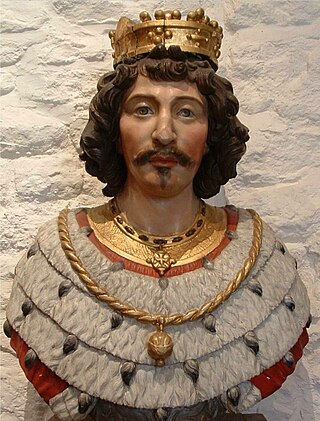
Soignies is a municipality of Wallonia located in the province of Hainaut, Belgium.

Saint Waltrude is the patron saint of Mons, Belgium, where she is known in French as Sainte Waudru, and of Herentals, Belgium, where she is known in Dutch as Sint-Waldetrudis or -Waltrudis. Both cities boast a large medieval church that bears her name.

Vincent Madelgarius, aka Maelceadar, Benedictine monk, died 677. His feast day is September 20.

The Ducasse de Mons, also commonly known as the Doudou, is a traditional folk festival held in Mons, Hainaut, Belgium, on Trinity Sunday. The feast comprises two important parts: the procession, including the descent and the uprising of the Saint Waltrude's shrine, as well as the combat named Lumeçon between Saint George and a dragon. Since 2008, it is recognised as a Masterpiece of the Oral and Intangible Heritage of Humanity by UNESCO.

Aldetrude was a Christian saint and from 684 was abbess of Maubeuge Abbey in the County of Hainault, now in northern France. She is also known as Aldetrude de Maubeuge, Aldetrude of Maubod, Aldetrudis and Adeltrude.
The pagus of Brabant was a geographical region in the early Middle Ages, located in what is now Belgium. It was the first region known to have been called Brabant, and it included the modern capital of Belgium, Brussels. It was divided between the neighbouring counties of Flanders, Hainaut and Louvain (Leuven) in the eleventh century. It was the eastern part, which went to the Counts of Louvain, which kept the name in use, becoming the primary name of their much larger lordship. This led to other regions later being named Brabant - in particular, the French and Dutch-speaking areas east of the Dyle, including Leuven and Wavre, which are still known as "Brabant"; and secondly the province of North Brabant in the Netherlands.

Saint Madelberte of Maubeuge was a 7th-century nun related to the Merovingian dynasty. She became abbess of Maubeuge Abbey in the County of Hainaut, now in northern France near the Belgian border. She died in 705 or 706.
Brunulphe III or Brunulphe III of the Ardennes , was a Frankish nobleman and Merovingian Count of the Ardennes. He was assassinated by King Dagobert I in the Middle Ages.
Alberic of the Ardennes, Alberick, or Albéric l'Orphelin de Hainaut d'Ardenne, also called the Orphan, was a Frankish nobleman and Merovingian Count of Hainaut.
Brunulphe or Brunulphe of the Ardennes was a Frankish nobleman and Merovingian Count of the Ardennes.
Saint Bertille of Thuringia(French: Sainte Bertille de Thuringe or also known as Saint Bertilla, the daughter of Bercarius, King of Thuringia, was a Merovingian princess and Frankish saint who resided in the County of Hainaut in Belgium. Bertille was the mother of Saint Waltrude and Saint Aldegund, foundress of Maubeuge Abbey.
Saint Walbert IV(French: Sainte Walbert IV), also known as Vaubert, Waubert, or Waudbert was a Merovingian Count of Hainaut and a Frankish saint. He was the father of Saint Waltrude, and Saint Aldegund, first abbess of Maubeuge.
Walbert I, Vaubert, Waudbert, or Vautier also known as Walbert of the Ardennes was a Frankish nobleman and a Merovingian Count of Hainaut.
Walbert II also called the Younger, was a patrician, Roman senator, and Merovingian Count of Haynau and of the Ardennes.
Hydulphe, Hydulphus, Hidulphe, Hidulf, commonly known as Hydulphe of Lobbes(French: Hydulphe de Lobbes) was a Frankish saint who helped Saint Landelin establish Lobbes Abbey, Crespin Abbey, and Aulne Abbey.
Walbert III was a Frankish nobleman and a Merovingian Count.

Dentelin, Dentelinus, or Saint Dentelin of Soignies was a Frankish saint. He was the son of Saint Waltrude and Madelgaire.

Aubert of Cambrai or Aubertus was a Merovingian Bishop of Cambrai and Arras and a Frankish saint.

Collegiate Church of Saint-Vincent de Soignies or Saint-Vincent Collegiate Church of Soignies is a church located in Soignies, Hainaut Province in Belgium.

Hautmont Abbey or the Abbey of Hautmont, was a Benedictine monastery in Hautmont in the department of Nord, France.











